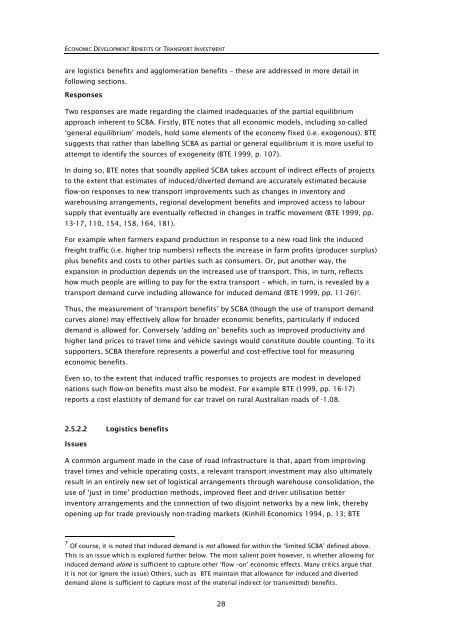Research 350 - NZ Transport Agency
Research 350 - NZ Transport Agency
Research 350 - NZ Transport Agency
You also want an ePaper? Increase the reach of your titles
YUMPU automatically turns print PDFs into web optimized ePapers that Google loves.
ECONOMIC DEVELOPMENT BENEFITS OF TRANSPORT INVESTMENT<br />
are logistics benefits and agglomeration benefits – these are addressed in more detail in<br />
following sections.<br />
Responses<br />
Two responses are made regarding the claimed inadequacies of the partial equilibrium<br />
approach inherent to SCBA. Firstly, BTE notes that all economic models, including so-called<br />
‘general equilibrium’ models, hold some elements of the economy fixed (i.e. exogenous). BTE<br />
suggests that rather than labelling SCBA as partial or general equilibrium it is more useful to<br />
attempt to identify the sources of exogeneity (BTE 1999, p. 107).<br />
In doing so, BTE notes that soundly applied SCBA takes account of indirect effects of projects<br />
to the extent that estimates of induced/diverted demand are accurately estimated because<br />
flow-on responses to new transport improvements such as changes in inventory and<br />
warehousing arrangements, regional development benefits and improved access to labour<br />
supply that eventually are eventually reflected in changes in traffic movement (BTE 1999, pp.<br />
13-17, 110, 154, 158, 164, 181).<br />
For example when farmers expand production in response to a new road link the induced<br />
freight traffic (i.e. higher trip numbers) reflects the increase in farm profits (producer surplus)<br />
plus benefits and costs to other parties such as consumers. Or, put another way, the<br />
expansion in production depends on the increased use of transport. This, in turn, reflects<br />
how much people are willing to pay for the extra transport – which, in turn, is revealed by a<br />
transport demand curve including allowance for induced demand (BTE 1999, pp. 11-26) 7 .<br />
Thus, the measurement of ‘transport benefits’ by SCBA (though the use of transport demand<br />
curves alone) may effectively allow for broader economic benefits, particularly if induced<br />
demand is allowed for. Conversely ‘adding on’ benefits such as improved productivity and<br />
higher land prices to travel time and vehicle savings would constitute double counting. To its<br />
supporters, SCBA therefore represents a powerful and cost-effective tool for measuring<br />
economic benefits.<br />
Even so, to the extent that induced traffic responses to projects are modest in developed<br />
nations such flow-on benefits must also be modest. For example BTE (1999, pp. 16-17)<br />
reports a cost elasticity of demand for car travel on rural Australian roads of -1.08.<br />
2.5.2.2 Logistics benefits<br />
Issues<br />
A common argument made in the case of road infrastructure is that, apart from improving<br />
travel times and vehicle operating costs, a relevant transport investment may also ultimately<br />
result in an entirely new set of logistical arrangements through warehouse consolidation, the<br />
use of ‘just in time’ production methods, improved fleet and driver utilisation better<br />
inventory arrangements and the connection of two disjoint networks by a new link, thereby<br />
opening up for trade previously non-trading markets (Kinhill Economics 1994, p. 13; BTE<br />
7 Of course, it is noted that induced demand is not allowed for within the ‘limited SCBA’ defined above.<br />
This is an issue which is explored further below. The most salient point however, is whether allowing for<br />
induced demand alone is sufficient to capture other ‘flow –on’ economic effects. Many critics argue that<br />
it is not (or ignore the issue) Others, such as BTE maintain that allowance for induced and diverted<br />
demand alone is sufficient to capture most of the material indirect (or transmitted) benefits.<br />
28
















